This site uses affiliate links, meaning that if you make a purchase through our links, we may earn an affiliate commission.
Unlock the secrets of ancient Egypt and embark on an epic journey as we guide you through the awe-inspiring wonders of the magnificent Karnak Temple in Luxor.
Nestled on the banks of the timeless Nile River, this colossal complex stands as a testament to the grandeur of ancient Egypt!
In this guide, we will lead you through the hallowed halls and towering obelisks, revealing not just the architectural marvels but also the captivating stories etched into every stone.
Brace yourself for an expedition into history’s embrace, where the echoes of pharaohs and the whispers of gods still linger, and where every step is a testament to human ingenuity and the passage of millennia. Here is how to visit Karnak Temple and uncover 9 amazing things you can’t miss!
The Temple of Hatshepsut
- 1. What You Need to Know About Karnak Temple Before You Visit
- 1.1. When Was Karnak Temple Built
- 1.2. Who Built Karnak Temple
- 1.3. What Does Karnak Mean
- 1.4. Why Is the Temple of Karnak Famous
- 1.5. How to Get to Karnak Temple
- 1.6. How Long Does It Take to Visit Karnak Temple
- 2. Map of Karnak Temple with 9 Things You Can't Miss
- 3. 9 Things You Can't Miss at Karnak Temple
- 3.1. The Avenue of Sphinxes
- 3.2. The First Pylon
- 3.3. The Great Court
- 3.4. The Second Pylon
- 3.5. The Great Hypostyle Hall at Karnak Temple
- 3.6. The Obelisks
- 3.7. The Great Festival Hall of Thutmose III
- 3.8. The Seventh Pylon
- 3.9. The Scared Lake
- 4. Don't Miss the Sound and Light Show at Karnak Temple
- 5. Intrepid Scout's Tips for How to Visit Karnak Temple
What You Need to Know About Karnak Temple Before You Visit
Karnak is a massive Ancient Egyptian temple complex.
At the heart of it lies the Temple of Amun, dedicated to the king of the gods.
In addition, there are several smaller temples, chapels, and sanctuaries dedicated to other deities. Moreover, there are endless halls, a sacred lake, pylons, colossi, and obelisks.
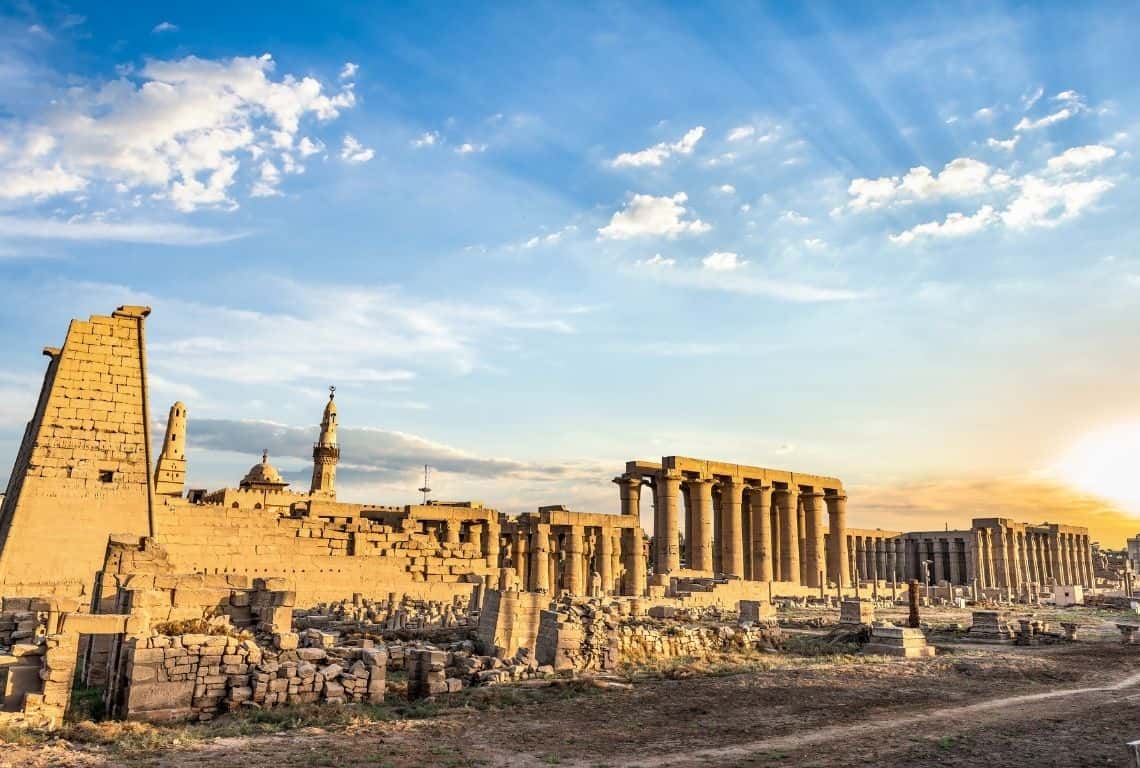
Karnak is a massive Ancient Egyptian temple complex. At the heart of it lies the Temple of Amun / How to Visit Karnak Temple
When Was Karnak Temple Built
Construction at the complex began during the reign of Senusret I in the Middle Kingdom (around 2000-1700 BC) and continued into the Ptolemaic period (305 – 30 BC). However, most of the structures date from the New Kingdom.
The New Kingdom also referred to as the Egyptian Empire, is the period in ancient Egyptian history between the 16th century BC and the 11th century BC, covering the 18th, 19th, and 20th dynasties of Egypt. It was Egypt’s most prosperous time and marked the peak of its power.
Who Built Karnak Temple
From the beginning of the 11th Dynasty, pharaoh after pharaoh rebuilt, expanded, restored, or changed the existing structures at the Temple of Karnak. Their goal was to make a mark on Egypt’s most important temple. It was a way to ensure immortality.
Today, you can still see many structures contributed by pharaohs such as Hatshepsut, Tuthmose III, Seti I, Ramses II, and many others.
What Does Karnak Mean
Karnak is the modern name of this temple complex.
The Ancient Egyptians called the site Nesut-Towi, “Throne of the Two Lands”, Ipet-Iset, “The Finest of Seats” as well as Ipt-Swt, “Selected Spot” (also given as Ipetsut, “The Most Select of Places”). Source: Ancient History Encyclopedia
During the Muslim conquest of Egypt, which took place between 639 and 646 AD, the temple complex started to be called ‘Ka-ranak’, which means a ‘fortified village’.
When European explorers first began traveling in Egypt in the 17th century AD, they adopted, as well as modified the name and started referring to the temple complex as ‘Karnak’ and the name has been in use ever since.
Why Is the Temple of Karnak Famous
The Temple of Karnak is famous for two main reasons:
- First of all, the Temple of Karnak was built over the centuries. Each ruler added to the temple complex, and changed, or restored the existing structures.
The process started at the beginning of the Middle Kingdom, went through the New Kingdom, and continued throughout the Ptolemaic Dynasty. However, it has been suggested that the rulers of the Old Kingdom first started to build at the site of the temple complex due to the style of some of the ruins.
- Second, it is the sheer size of the Temple of Karnak, that makes it so famous. The complex continued to expand with each succeeding ruler and the ruins today cover almost 250 acres of land.
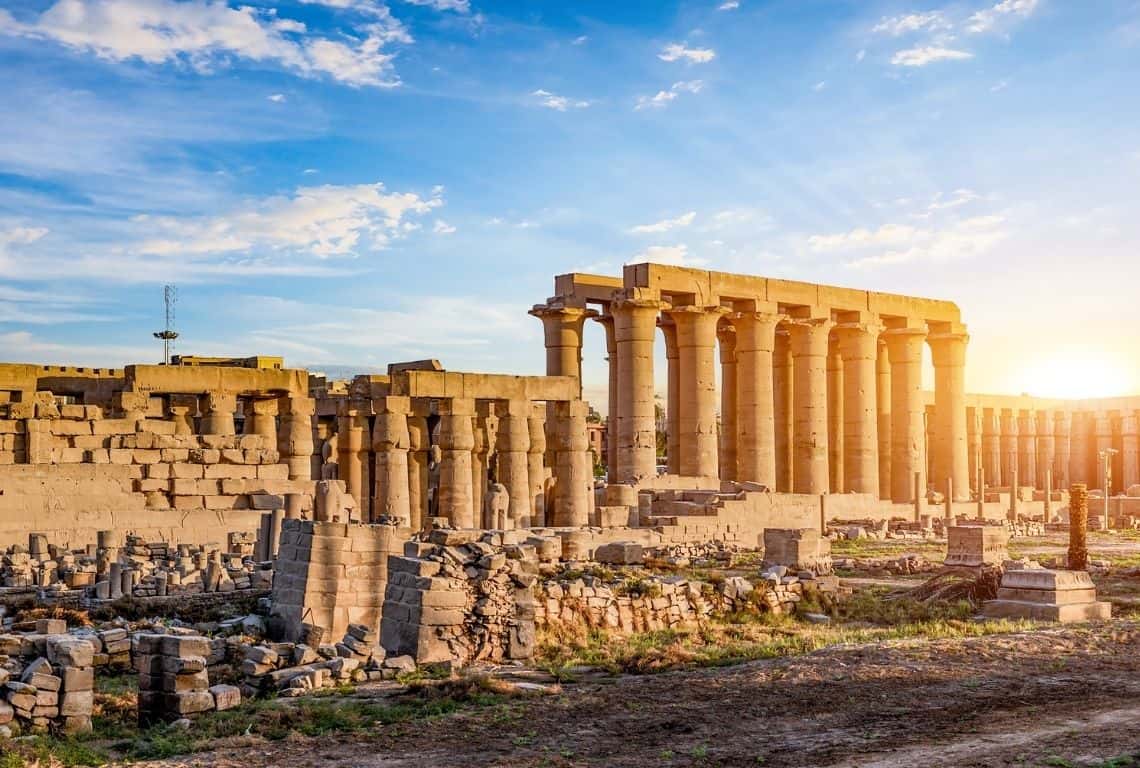
Karnak Temple at sunrise / How to Visit Karnak Temple in Luxor
How to Get to Karnak Temple
Karnak Temple is located on the east bank of the Nile River in Luxor.
The best way to get to Karnak Temple is by having a driver and a guide. This option gives you total flexibility. You can decide how much time you need to see everything at Karnak Temple. Plus, having a knowledgeable guide by your side is priceless! My guide gave me a tour of Karnak Temple that took about two hours, then he gave me another two hours to leisurely wander through all the areas by myself and take a ton of pictures.
You can ask your hotel for a bus tour that stops at all major attractions in Luxor. It is probably one of the least expensive options. But, it does not give you much flexibility.
Another option is to just book a taxi and head to the Temple of Karnak. You will always be able to hire a guide right at the entrance to Karnak Temple.
How Long Does It Take to Visit Karnak Temple
Karnak Temple Complex is vast. It takes time to walk from one section to the next. You are going to need to reserve at least 3 to 4 hours to just see the highlights of Karnak Temple.
If you are visiting during the summer months, make sure to carry plenty of water with you. Also, wear a hat and apply a ton of sunblock!
Map of Karnak Temple with 9 Things You Can't Miss
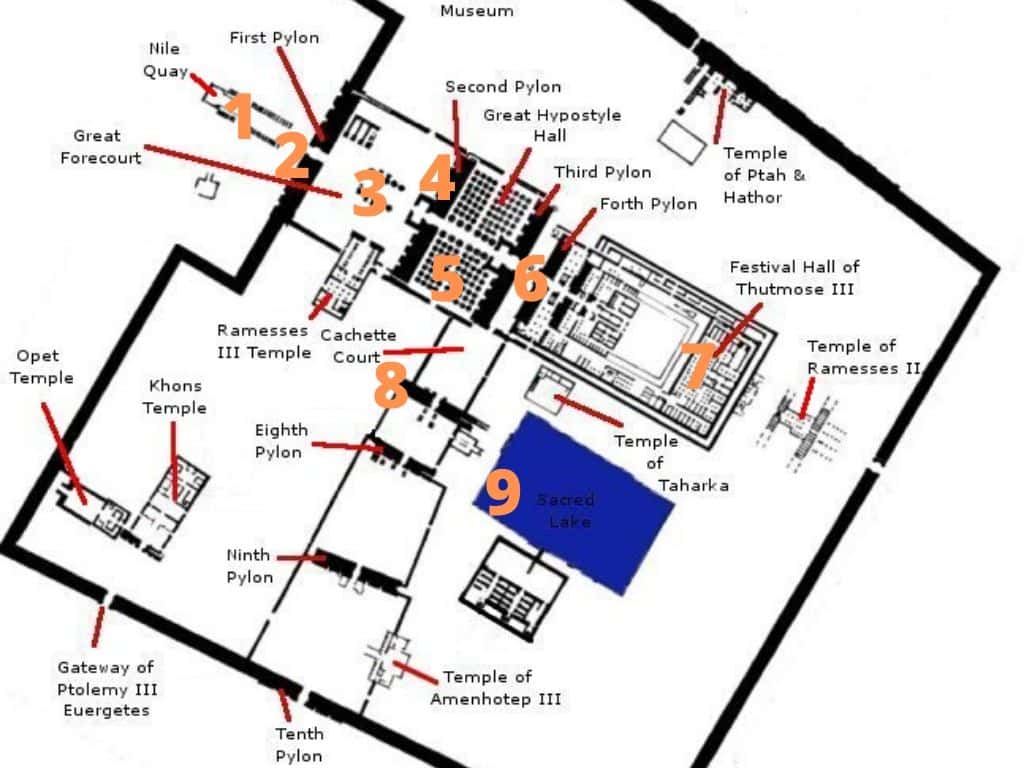
Map of Karnak Temple with 9 Things You Can’t-Miss. Image Source: Wikimedia Commons
Legend:
1. Avenue of Sphinxes
2. First Pylon
3. Great Court
4. Second Pylon
5. Great Hypostyle Court
6. Obelisks
7. Great Festival Hall of Thutmose III
8. Seventh Pylon of Thutmose III
9. Sacred Lake
9 Things You Can't Miss at Karnak Temple
Before we dive into the 9 things you can’t miss at Karnak Temple, what you need to know is that Karnak Temple was Egypt’s most important place of worship during the New Kingdom.
In addition, the temple complex consists of three main sacred areas that honor three gods:
- The largest precinct located in the center is the temple complex and it was principally dedicated to the god Amun.
- The second-largest precinct is located in the southern area of the complex. It was dedicated to the goddess Mut, wife of Amun.
- The smallest precinct is located in the northern section of the temple complex and it was dedicated to the god Montu, the god of war.
Amun, Mut, and their son, Khonsu, were members of the sacred family known as the Theban Triad.
Now, let’s focus on the best things to see at Karnak Temple! Here we go:
The Avenue of Sphinxes
Once you step inside the temple complex, you will be amazed by the Avenue of Sphinxes that lines the processional way leading to the Temple of Karnak. Between their paws stands a small statue of Ramses II.
They are not sphinxes, but rather criosphinxes, which are sphinxes with the head of a ram.
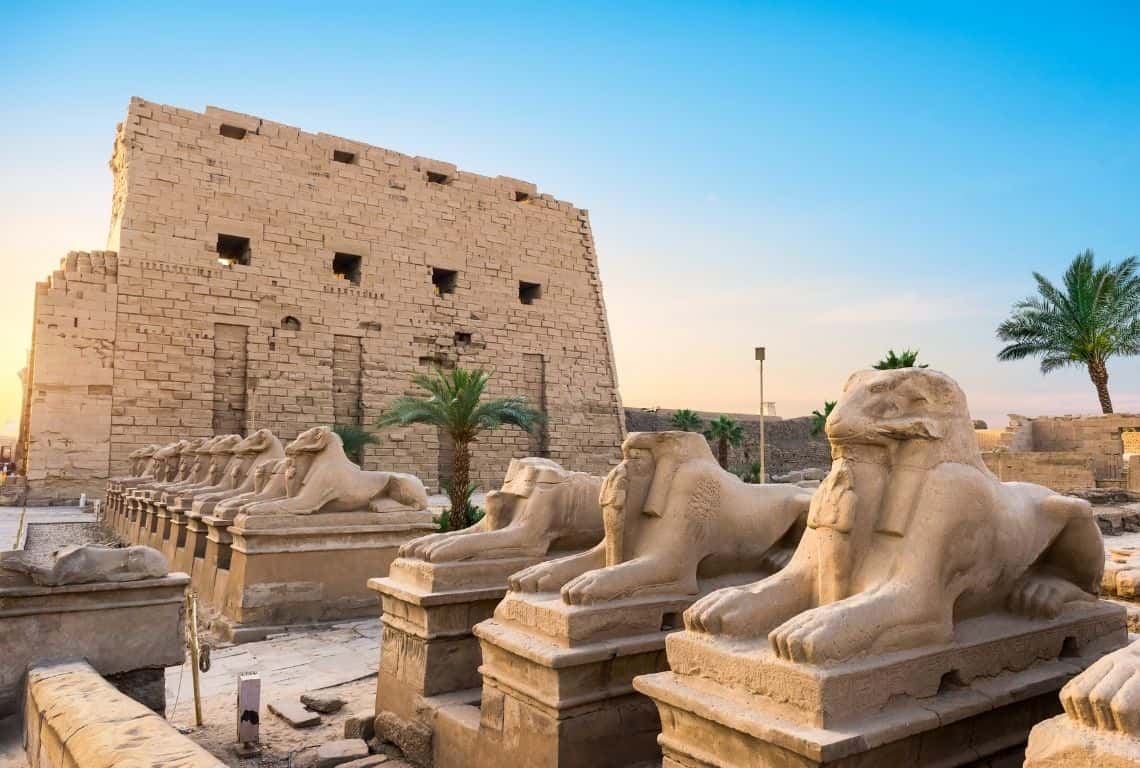
The Avenue of Sphinxes lines the processional way leading to the Temple of Karnak / How to Visit Karnak Temple
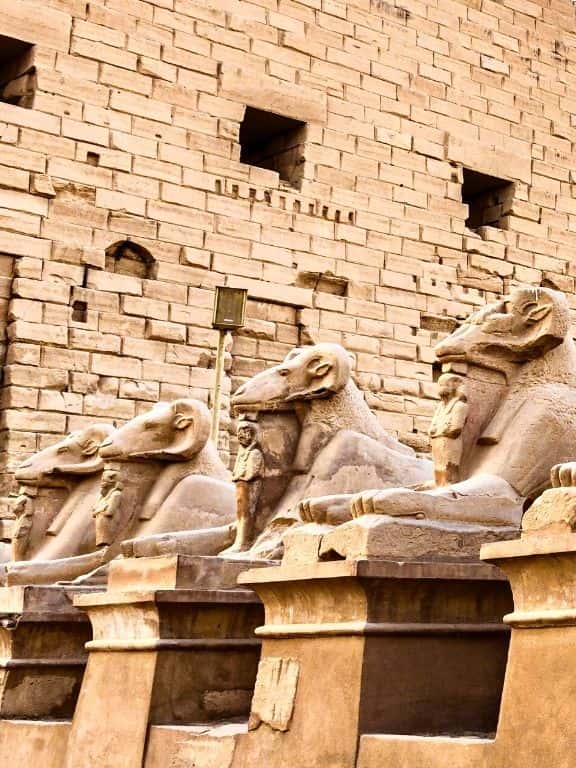
The Avenue of Sphinxes leads to the Temple of Karnak / How to Visit Karnak Temple
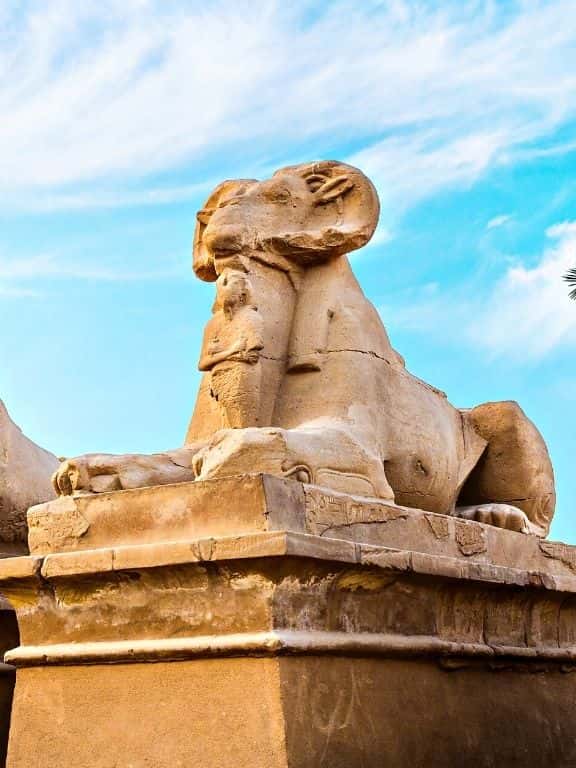
In between their paws are the statues of Ramses II / How to Visit Karnak Temple
The First Pylon
The Avenue of Sphinxes leads to the First Pylon. It was built by Nectanebo I.
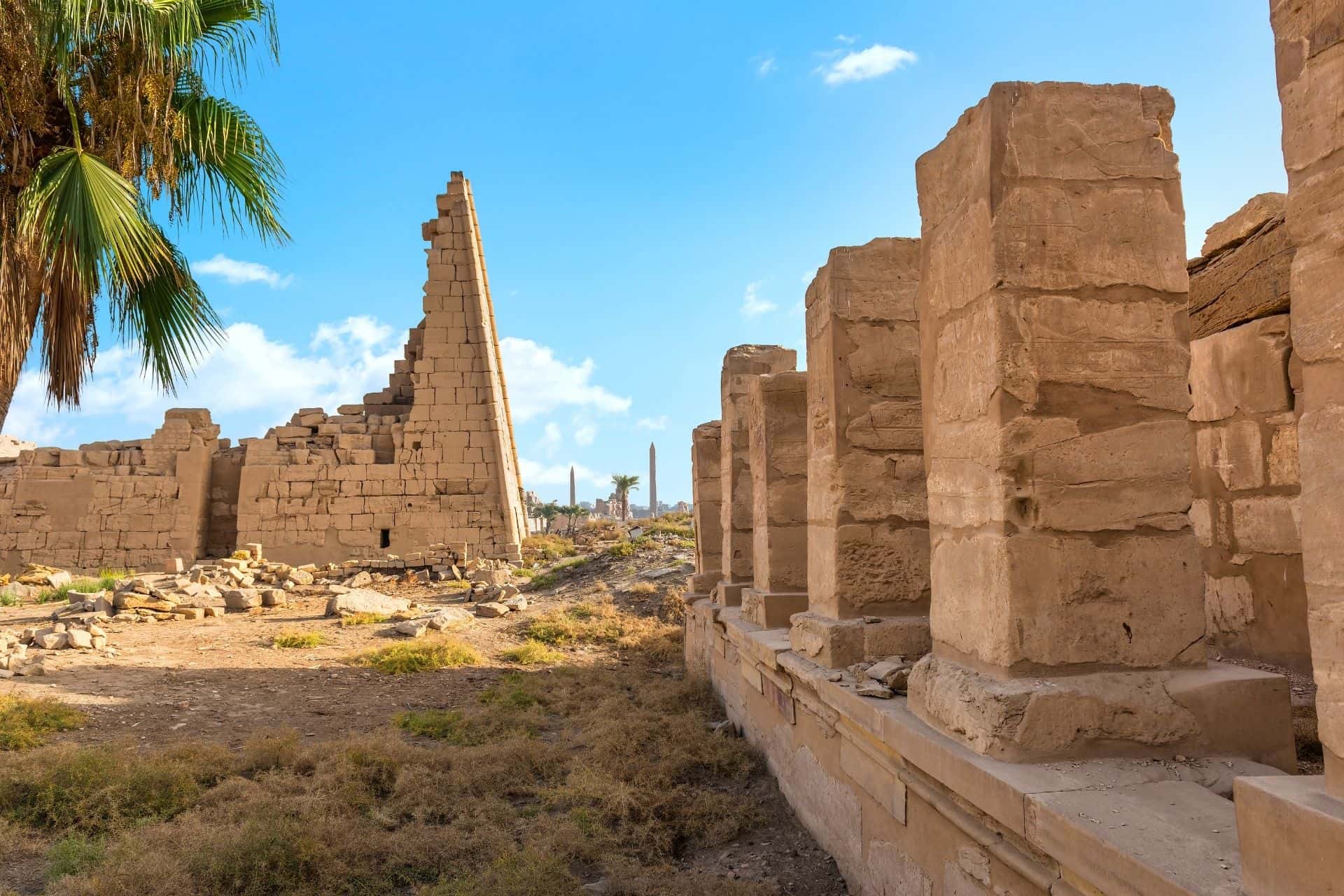
The First Pylon was built by Nectanebo I / What to See at Karnak Temple
The Great Court
Next, once you cross the First Pylon, you will step into the Great Court. Moreover, make sure to turn around and look at the back of the First Pylon. You will be able to see the mud-brick ramp that was left by the builders. Interestingly, the First Pylon was left unfinished.
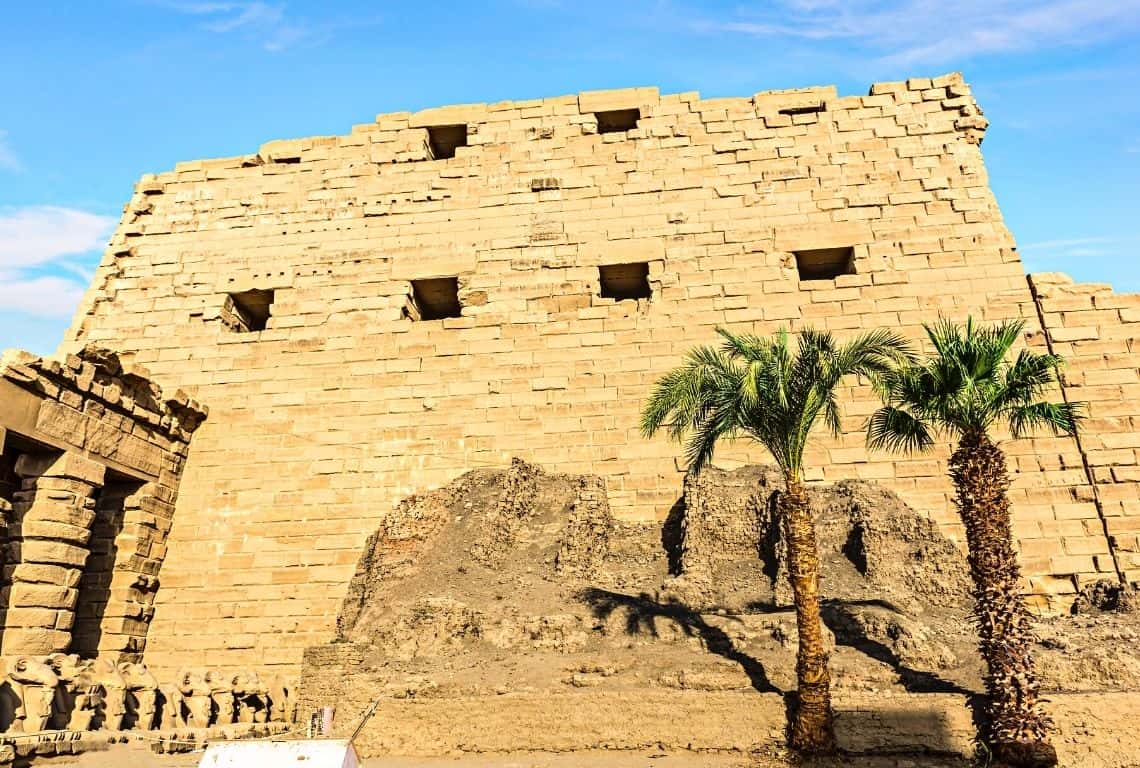
At the back of the First Pylon, you will be able to see the mud-brick ramp that was left by the builders / What to See at Karnak Temple
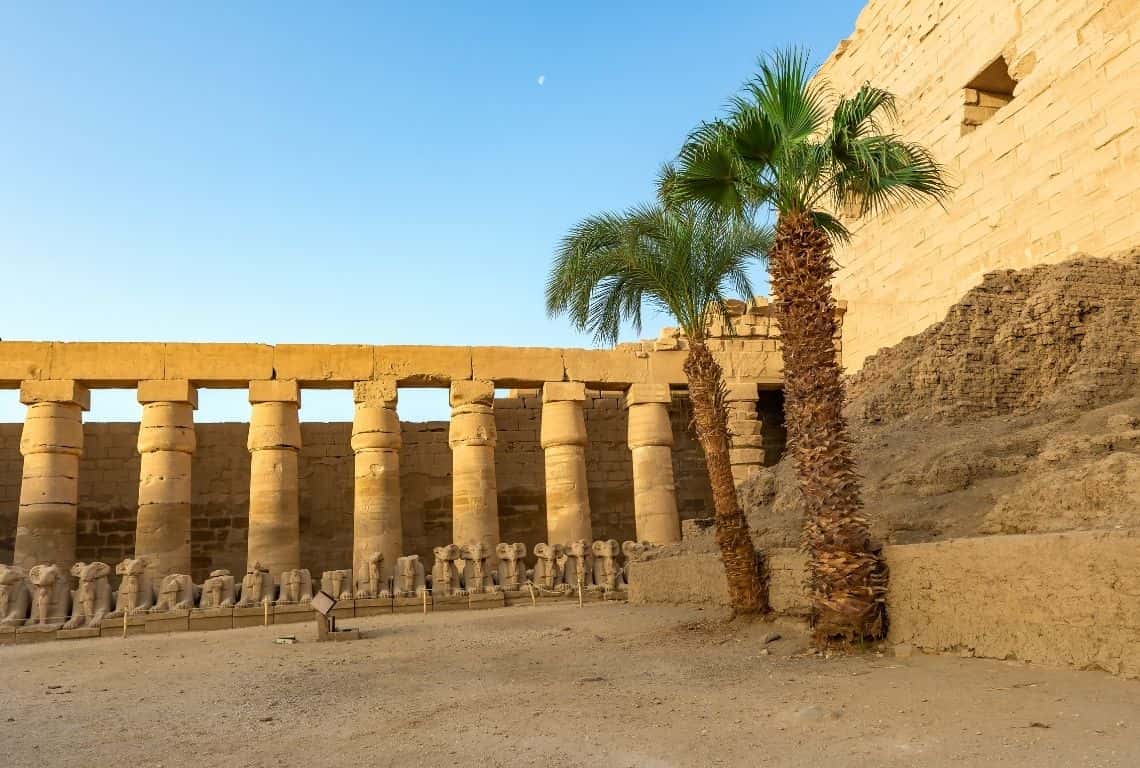
The back of the First Pylon with a mud-brick ramp was left by the builders / What to See at Karnak Temple
The row of ram-headed sphinxes lines the right-hand side of the Great Court.
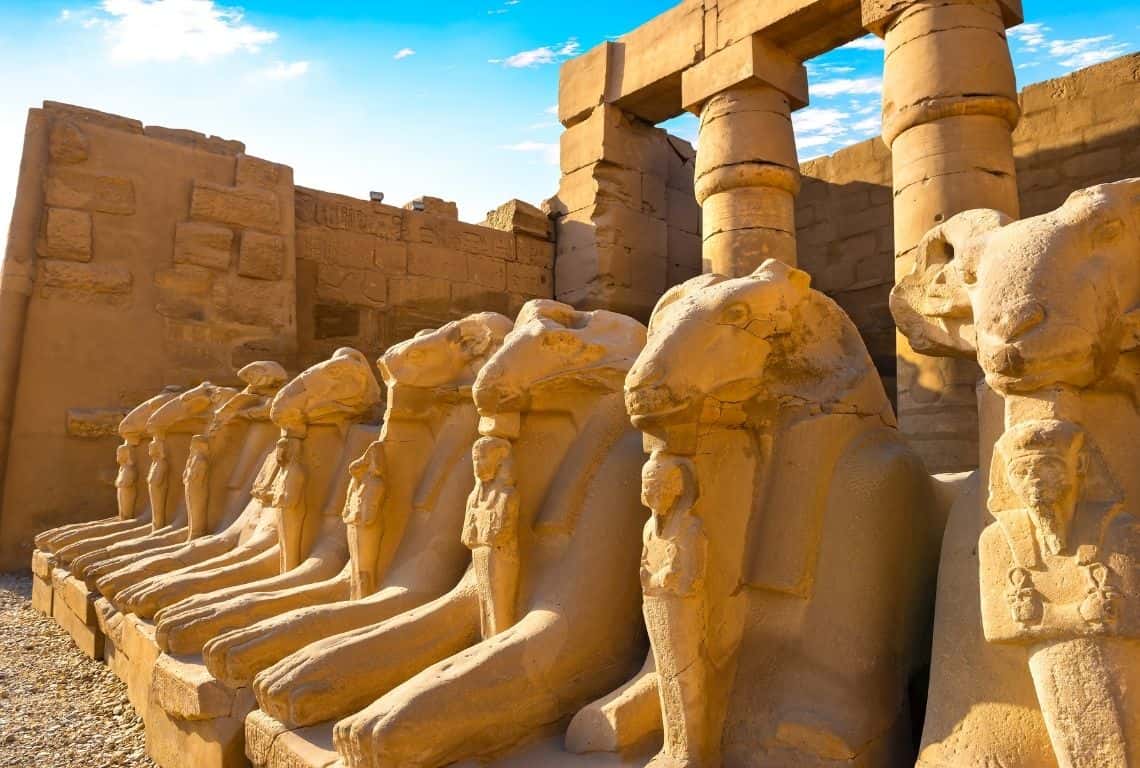
The row of ram-headed sphinxes lines the right-hand side of the Great Court / What to See at Karnak Temple in Luxor
The left-hand side of the Great Court is flanked by a colonnade.
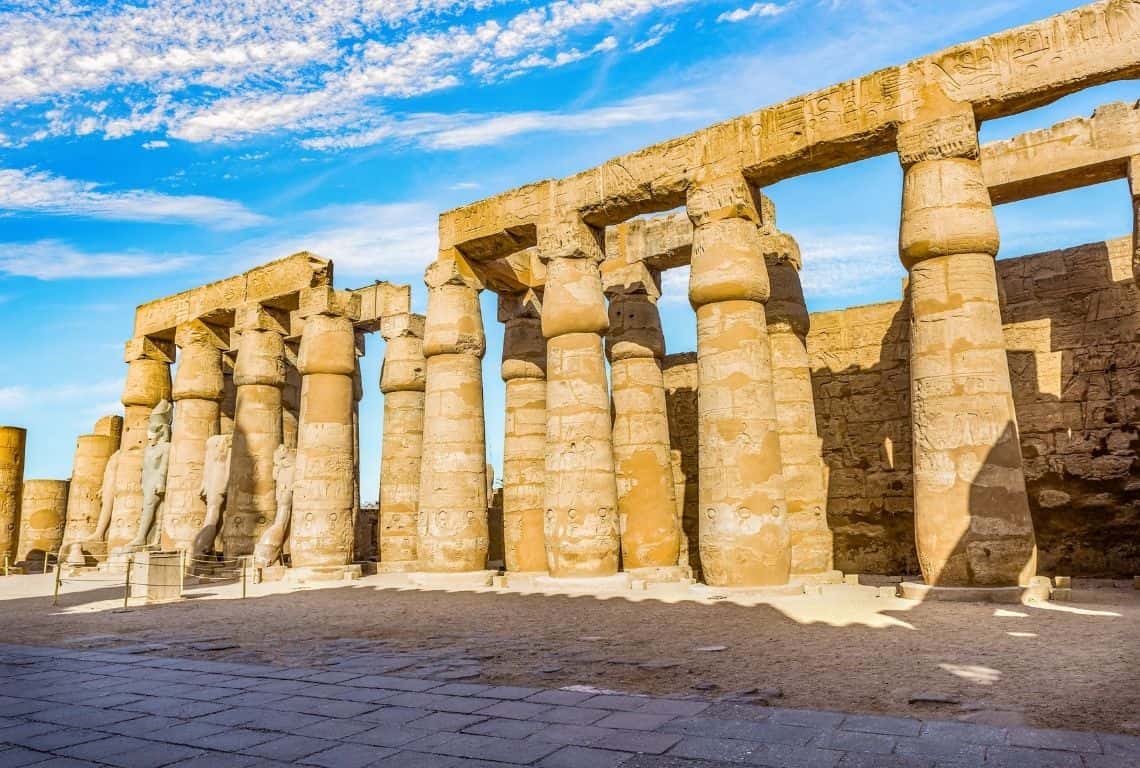
Beautiful colonnade on the left-hand side of the Great Court / How to Visit Karnak Temple in Luxor
Right in the middle of the Great Court are the remains of a huge kiosk built by Taharqa, the 25th Dynasty Pharaoh.
It originally consisted of 10 columns with open papyrus capitals linked by a low screening wall. Today, only one column remains standing.
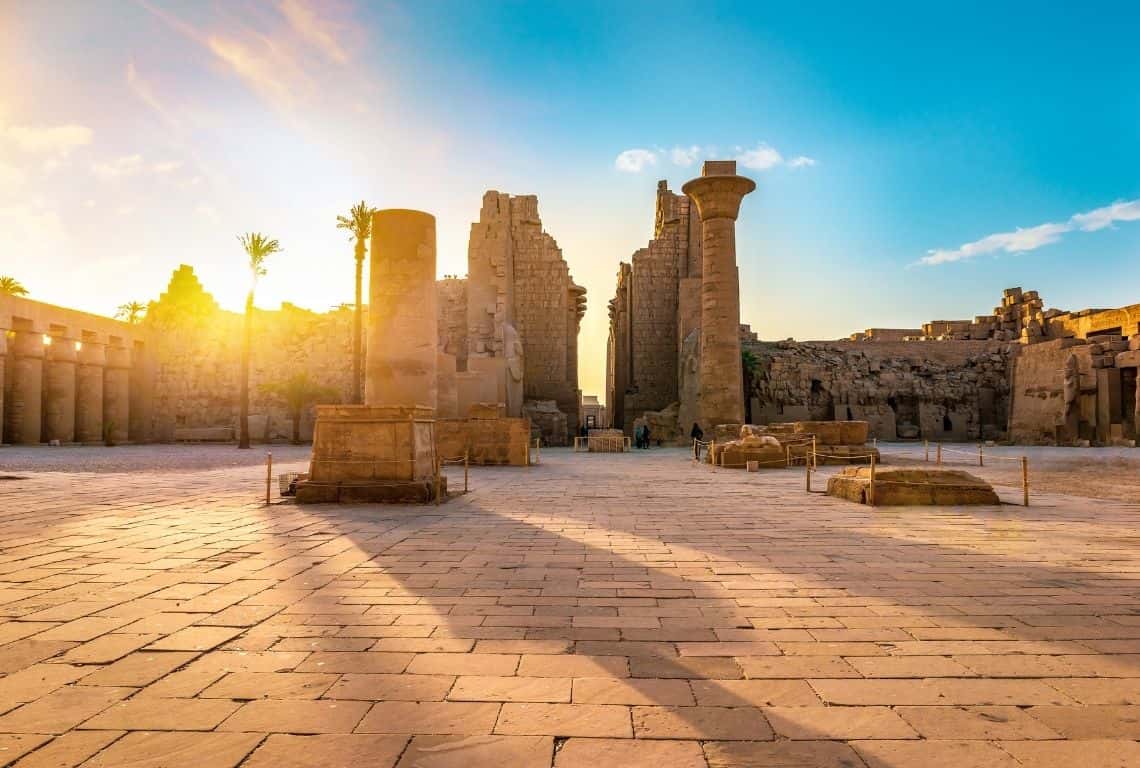
Right in the middle of the Great Court are the remains of a huge kiosk built by Taharqa, the 25th Dynasty Pharaoh. Today, only one column remains standing / What to See at Karnak Temple
The Great Court was built by Ramses II and his imposing statue flanks the entrance to the Second Pylon.
At his feet is a small figure of one of his daughters.
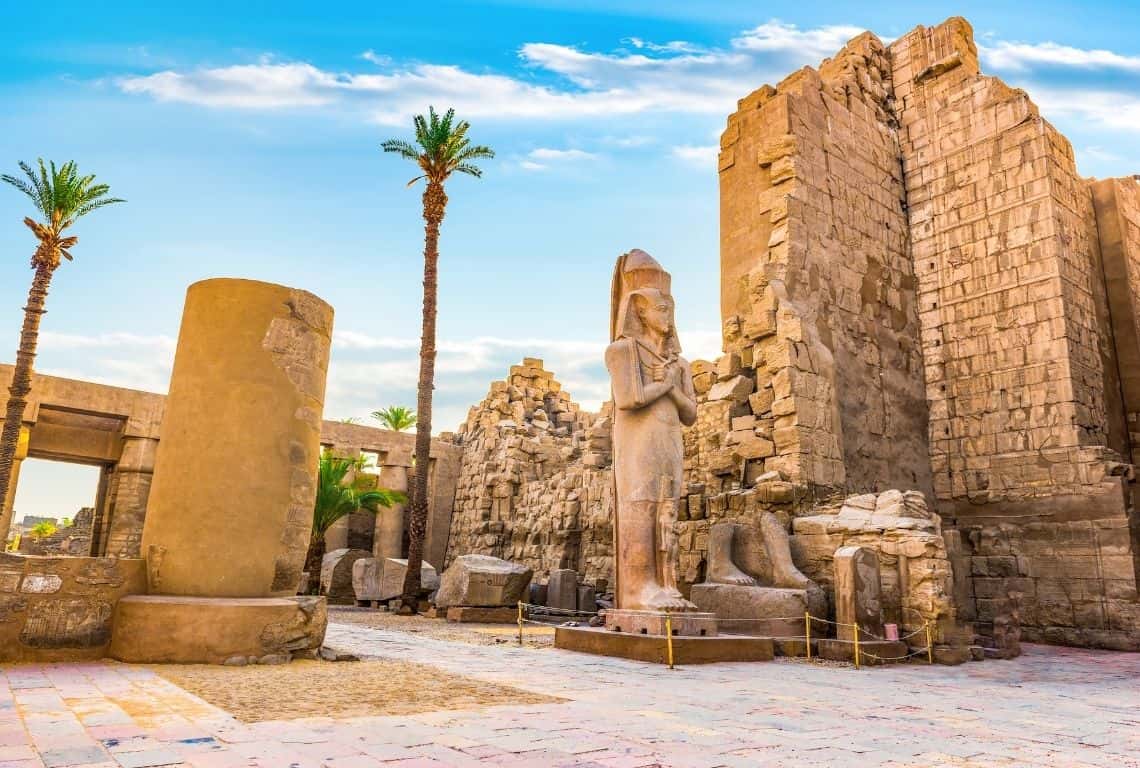
The Great Court was built by Ramses II and his imposing statue flanks the entrance to the Second Pylon / How to Visit Karnak Temple
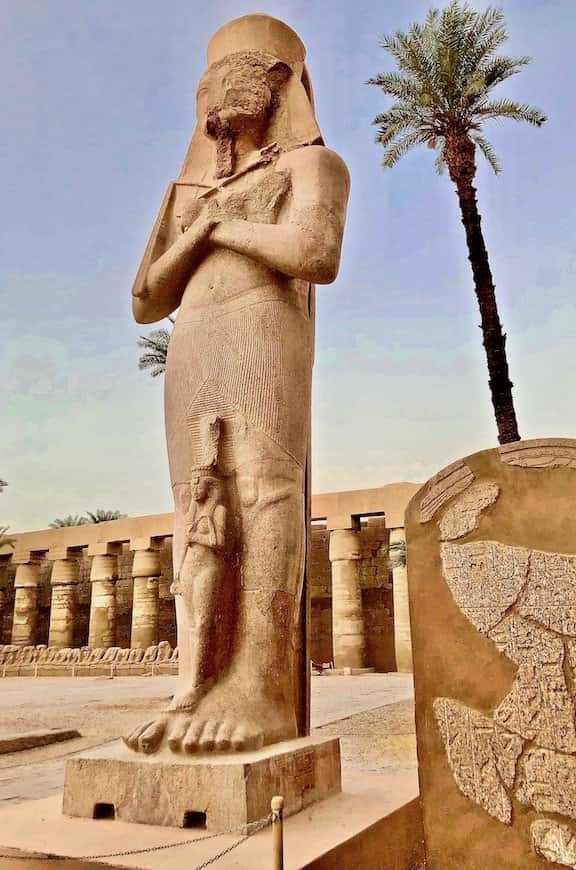
An imposing statue of Ramses II is flanking the entrance to the Second Pylon / What to See at Karnak Temple
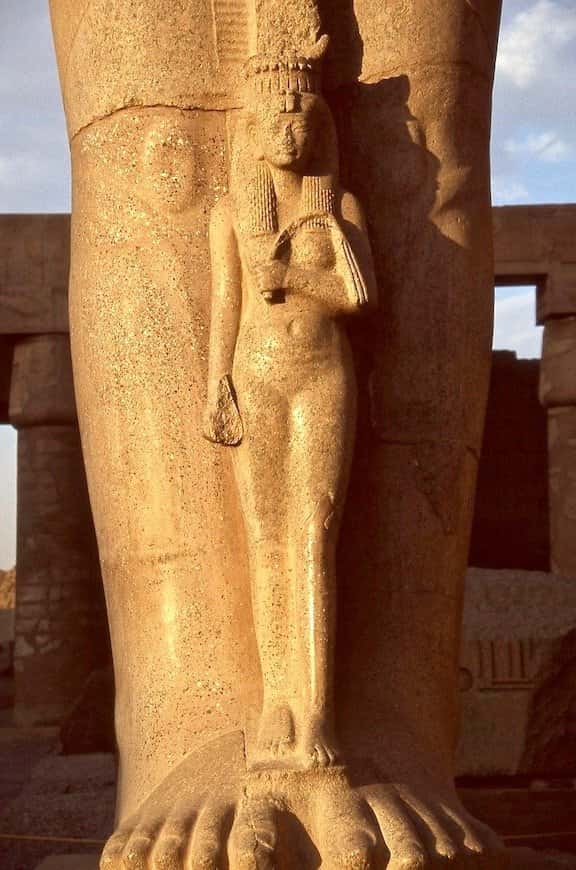
At the feet of Ramses II is a small figure of one of his daughters / How to Visit Karnak Temple
The Second Pylon
The Second Pylon was built by Horemheb. However, Horemheb left it unfinished.
Later on, Ramses I continued the work on the Second Pylon and replaced Horemheb’s cartouches with his own. Finally, Ramses II added to the Second Pylon and added his cartouches as well.
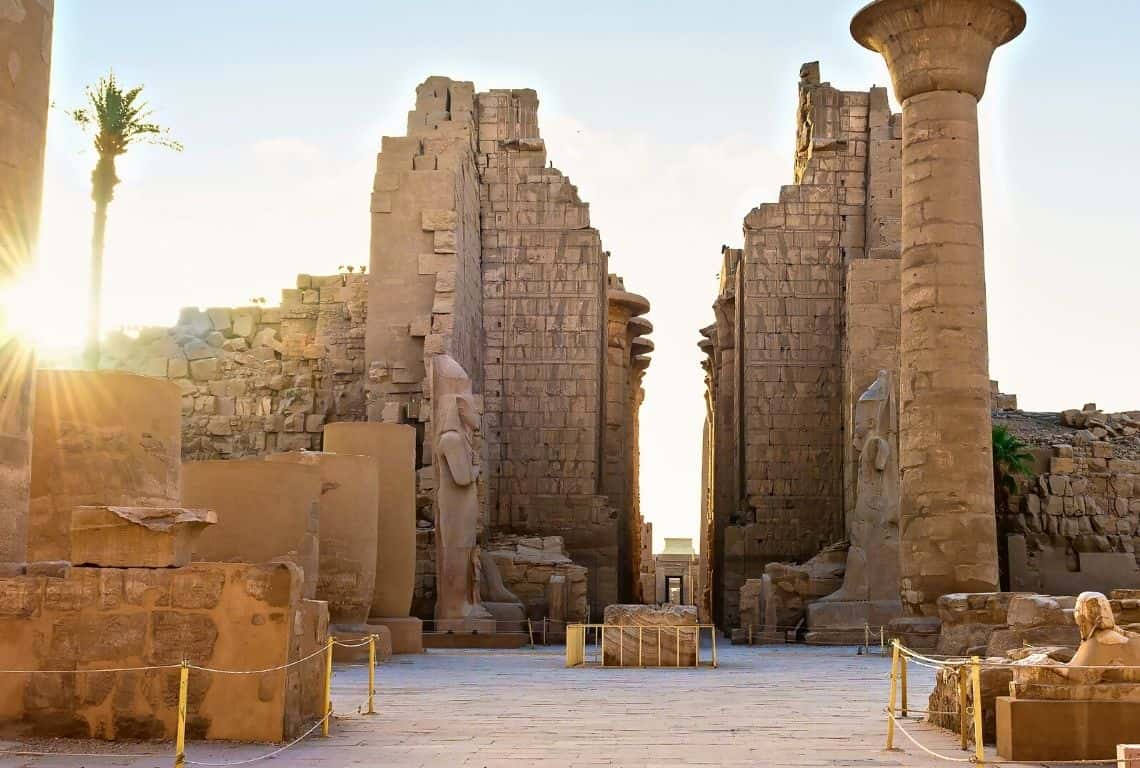
The Second Pylon was built by Horemheb. However, Horemheb left it unfinished / How to Visit Karnak Temple
The Great Hypostyle Hall at Karnak Temple
For me, the highlight of the entire tour of the Temple of Karnak was the Great Hypostyle Hall. It was built by Seti I and completed by Ramses II. The hall covers an area of about 50,000 sq ft. It contains 134 gigantic stone columns with beautiful capitals.
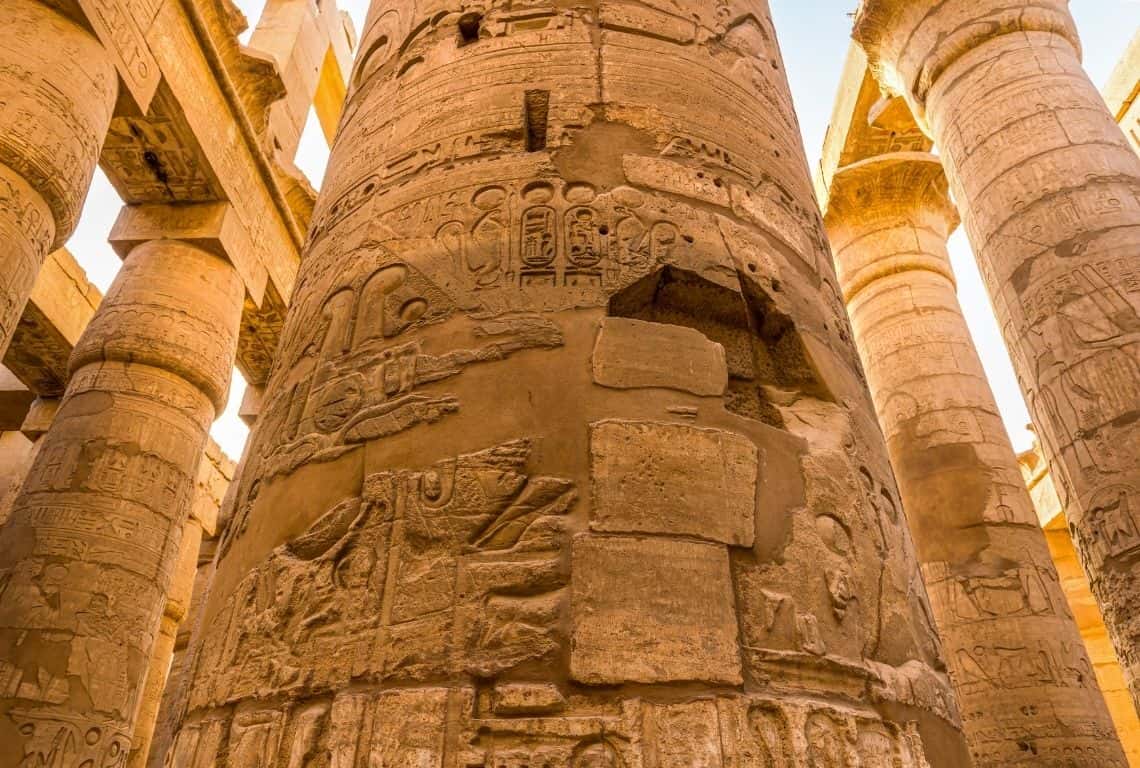
The Great Hypostyle Hall, built by Seti I and completed by Ramses II, covers an area of about 50,000 sq ft. It contains 134 gigantic stone columns with beautiful capitals / How to Visit Karnak Temple
Specifically, the center aisle consists of six columns with open papyrus capitals on each side. These columns are 21 meters tall with a diameter of over three meters.
Also, the center aisle columns support huge roofing slabs. These slabs called architraves are estimated to weigh 70 tons. There is still a lot of speculation about how these architraves were positioned on top of the columns.
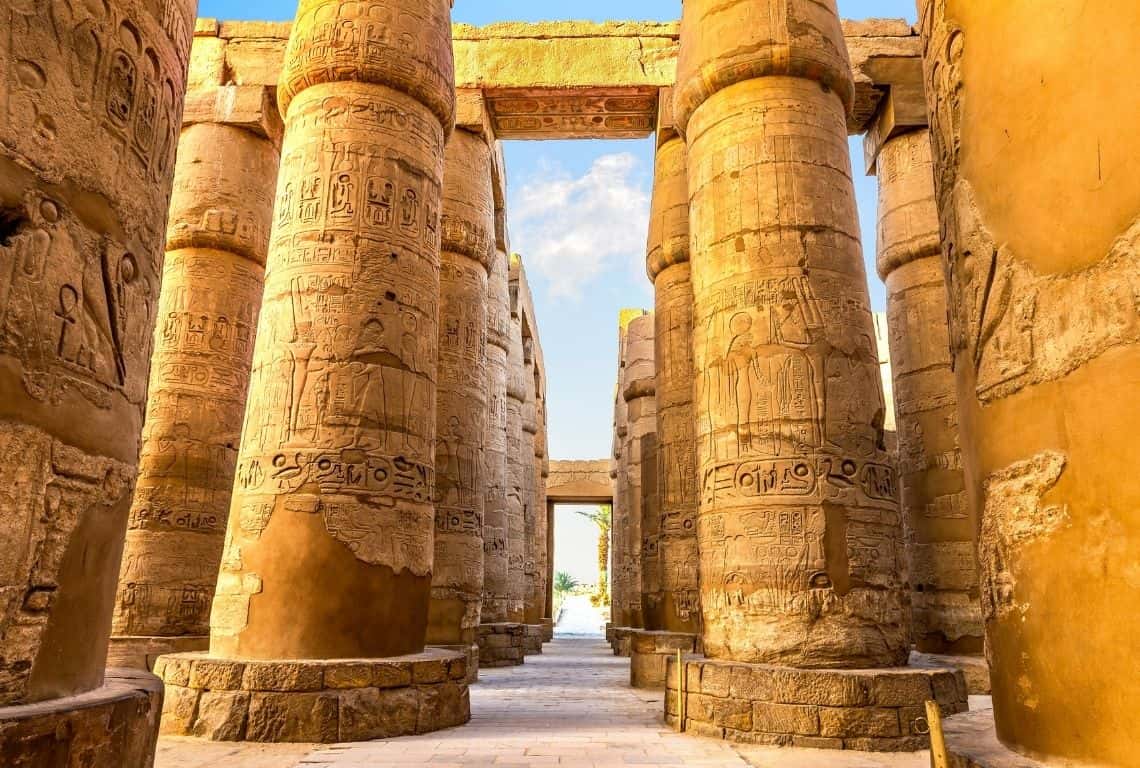
The center aisle columns support huge roofing slabs. These slabs called architraves are estimated to weigh 70 tons / How to Visit Karnak Temple
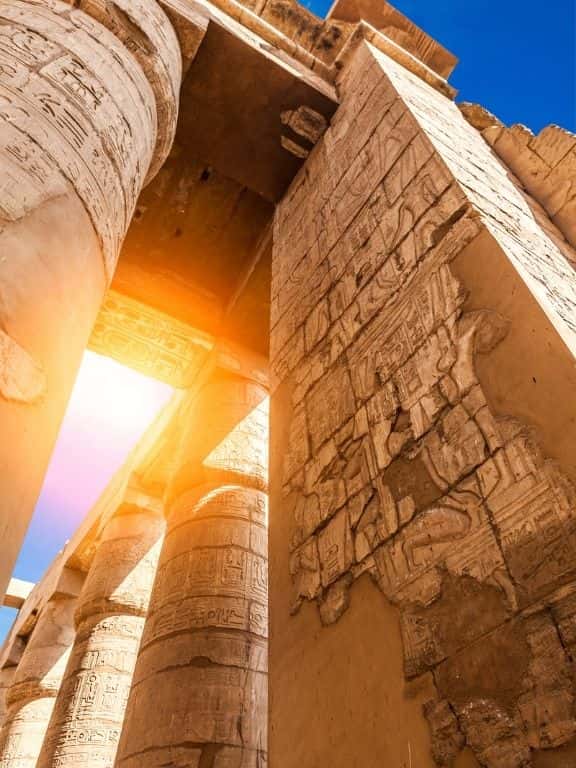
The center aisle consists of six columns with open papyrus capitals on each side / What to See at Karnak Temple
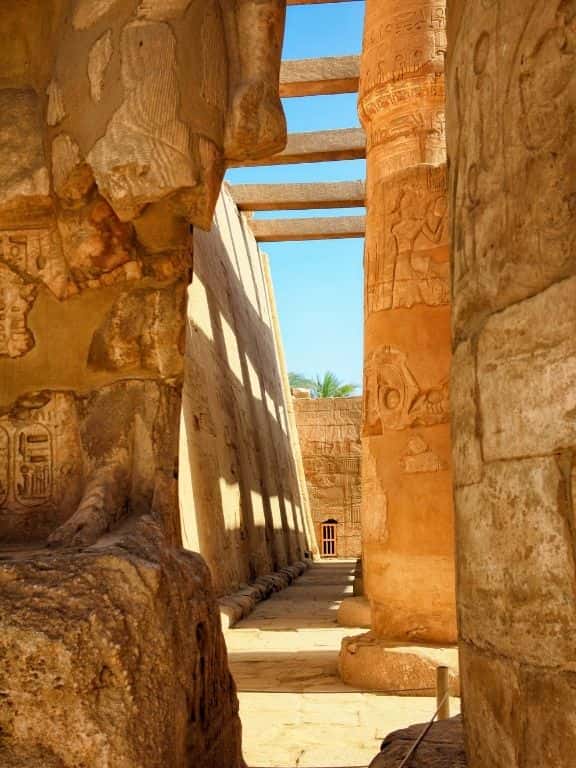
Columns are 21 meters tall with a diameter of over three meters / What to See at Karnak Temple
The Obelisks
After the Hypostyle Hall, the Third Pylon leads to the court where the Obelisk of Thutmose I stands. It is 22 meters tall.
As my tour guide told me, it is the only obelisk remaining out of the four that used to be in this court.
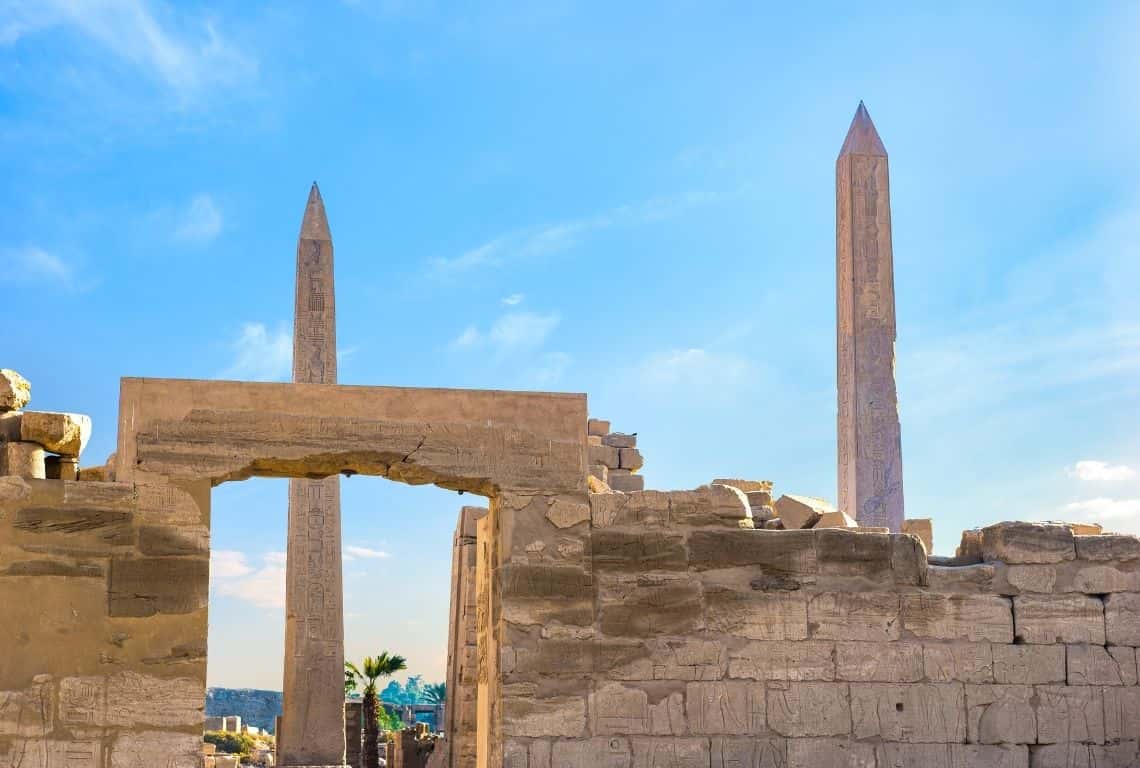
Obelisks at Karnak Temple / How to Visit Karnak Temple in Luxor
The Fourth Pylon leads to the remaining area of the temple. It is a court that contains Egypt’s tallest obelisk. It is almost 29 meters tall and it was commissioned by Hatshepsut.
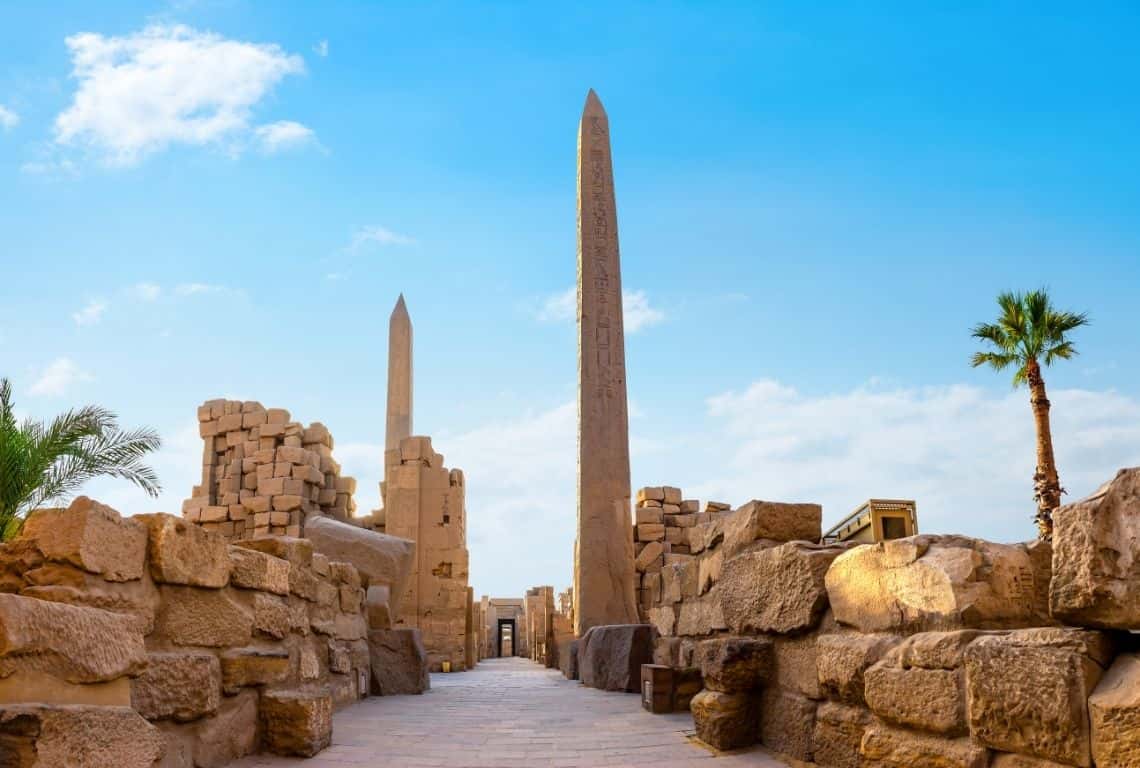
After the Hypostyle Hall, the Third Pylon leads to the court where the Obelisk of Thutmose I stands. It is 22 meters tall / How to See at Karnak Temple
Who Was Hatshepsut?
- Hatshepsut (born c. 1507 BC – died 1458 BC) was the daughter of Thutmose I. She became the queen of Egypt when she married her half-brother Thutmose II. Upon the death of Thutmose II, Hatshepsut began acting as regent for her stepson Thutmose III.
- Hatshepsut was supposed to control the affairs of the state until Thutmose III was to come of age. However, around 1473 BC, Hatshepsut broke with the tradition and had herself crowned as the pharaoh of Egypt becoming a co-ruler of Egypt with Thutmose III.
- Hatshepsut ruled for almost 20 years. She died about 1458 BC. How and why she died is still a mystery. What we know, is that Thutmose III had her name and image almost completely erased. She remained forgotten for centuries.
- Now, find out how Hatshepsut was rediscovered. Read about Hatshepsut’s accomplishments as a Pharaoh. Do not miss my post: The Temple of Hatshepsut in Luxor – Top Tips for Visiting. Plus, it has a ton of useful information to help you plan your visit to the Temple of Hatshepsut.
What is interesting is that Tuthmosis III built a high wall around her obelisk. It is a mystery why he built the wall. He could have destroyed the obelisk. Yet, it remained and is still standing today.
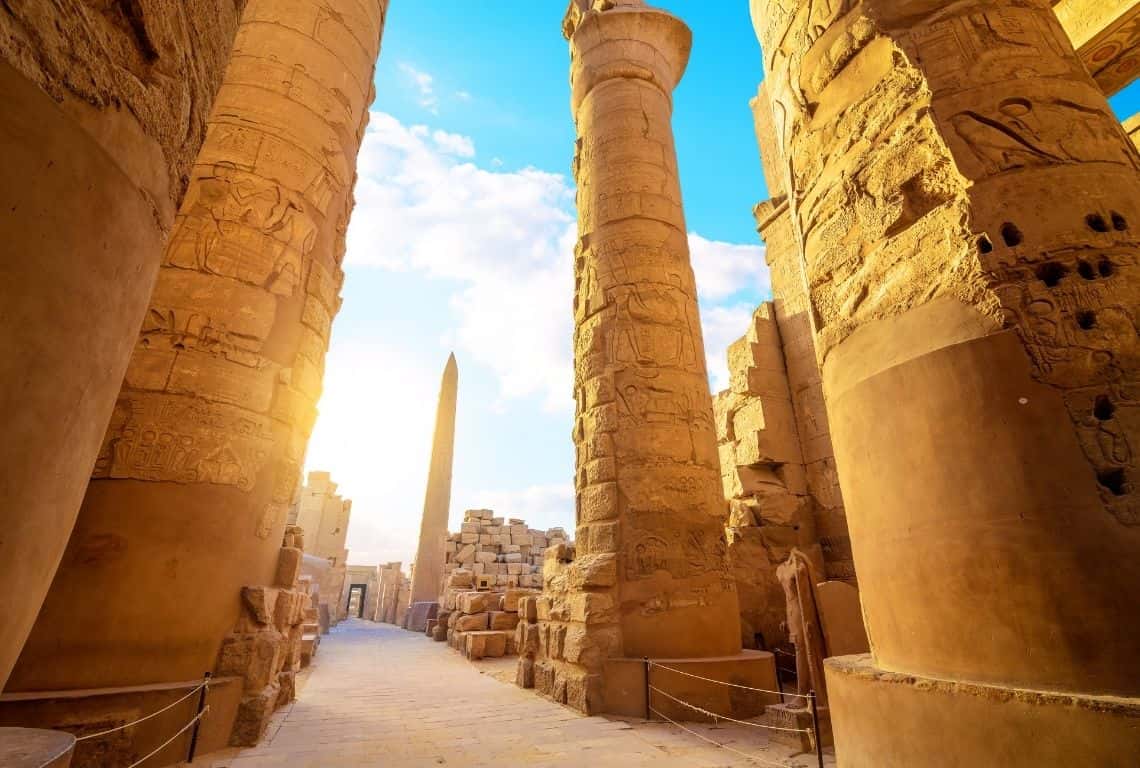
The Fourth Pylon leads to the remaining area of the temple. It is a court that contains Egypt’s tallest obelisk. It is almost 29 meters tall and it was commissioned by Hatshepsut / What to See at Karnak Temple in Luxor
The Great Festival Hall of Thutmose III
Once you pass through the fourth and fifth pylons, you will get to the Great Festival Hall of Thutmose III.
The parameter of the Great Festival Hall of Thutmose III is supported by 32 square pillars. However, what is really interesting is that the inside of the structure is supported by tent pole-style columns.
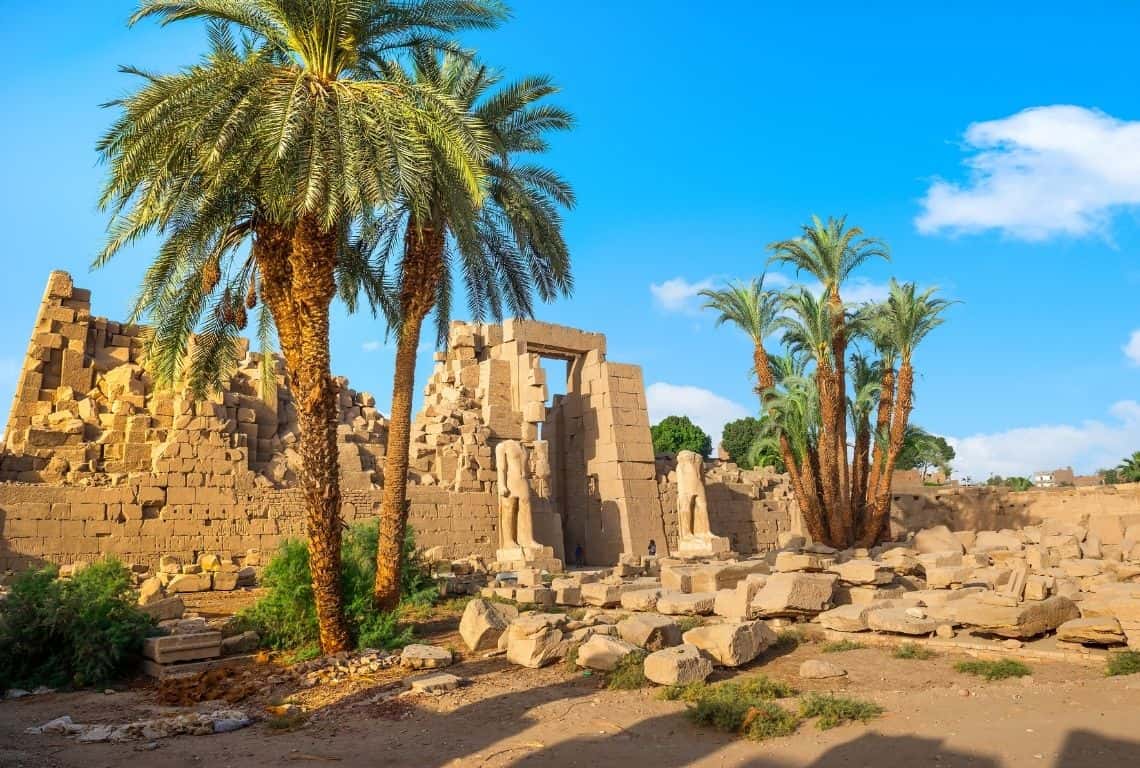
The parameter of the Great Festival Hall of Thutmose III is supported by 32 square pillars / How to Visit Karnak Temple
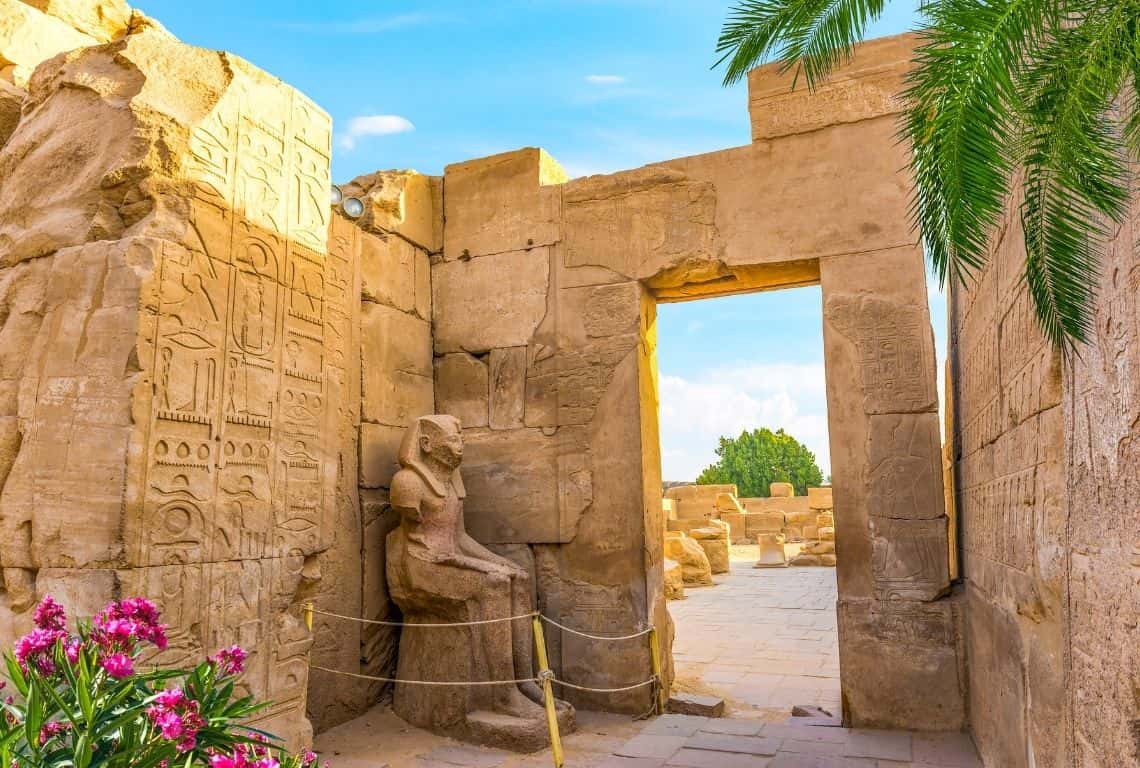
The parameter of the Great Festival Hall of Thutmose III is supported by 32 square pillars / How to Visit Karnak Temple
The Seventh Pylon
The Seventh Pylon must have been quite a structure judging from what remains of it today.
Today, we can still see the relief depicting Thutmose III defeating his enemies. Moreover, the two damaged statues flank the entrance of the Seventh Pylon.
Beyond the Seventh Pylon, you will find a courtyard called the Cachette. During the excavations, a large number of statues and stelae were found in this area. It is believed that these could have been the offerings of the worshipers.
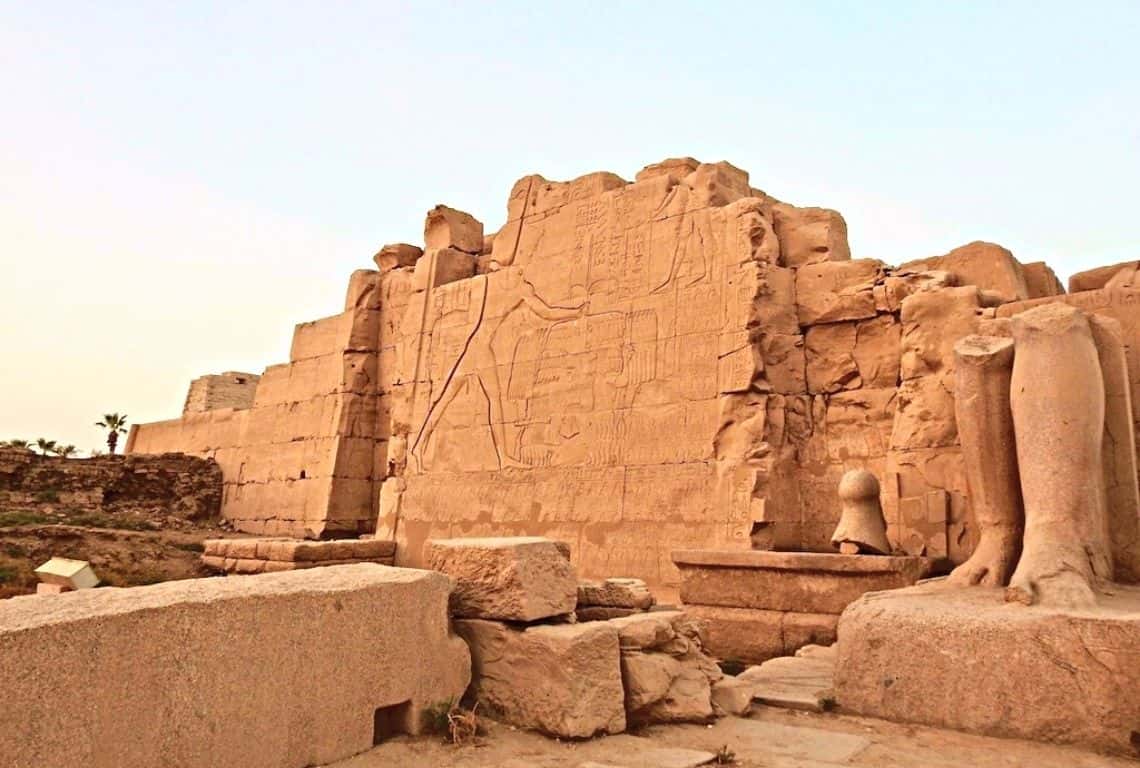
Today, we can still see the relief depicting Thutmose III defeating his enemies. Moreover, the two damaged statues flank the entrance of the Seventh Pylon / What to See at Karnak Temple in Luxor
The Scared Lake
The Sacred Lake is located in the southeastern part of the temple complex. The lake was constructed during the reign of Tuthmosis III. It was used by priests for purification ceremonies.
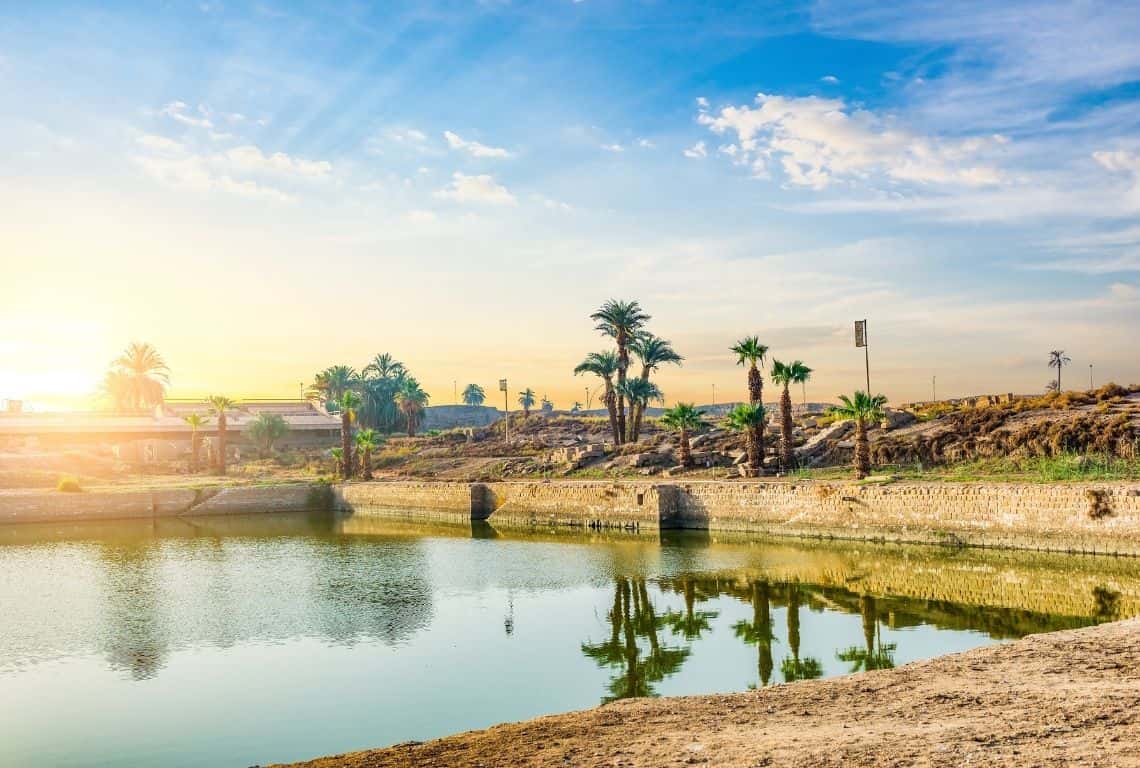
The Sacred Lake was constructed during the reign of Tuthmosis III. It was used by priests for purification ceremonies / What to See at Karnak Temple in Luxor
Right next to the Sacred Lake, you will be able to see the popular statue of the scarab.
Through modern cinema and film, Western society has come to perceive the Egyptian scarab as a destructive and evil entity, but the ancient Egyptian understanding of the beetle was very different.
The Egyptians saw the Egyptian scarab (Scarabaeus sacer) as a symbol of renewal and rebirth.
The beetle was associated closely with the sun god because scarabs roll large balls of dung in which to lay their eggs, a behavior that the Egyptians thought resembled the progression of the sun through the sky from east to west. Its young were hatched from this ball, and this event was seen as an act of spontaneous self-creation, giving the beetle an even stronger association with the sun god’s creative force.
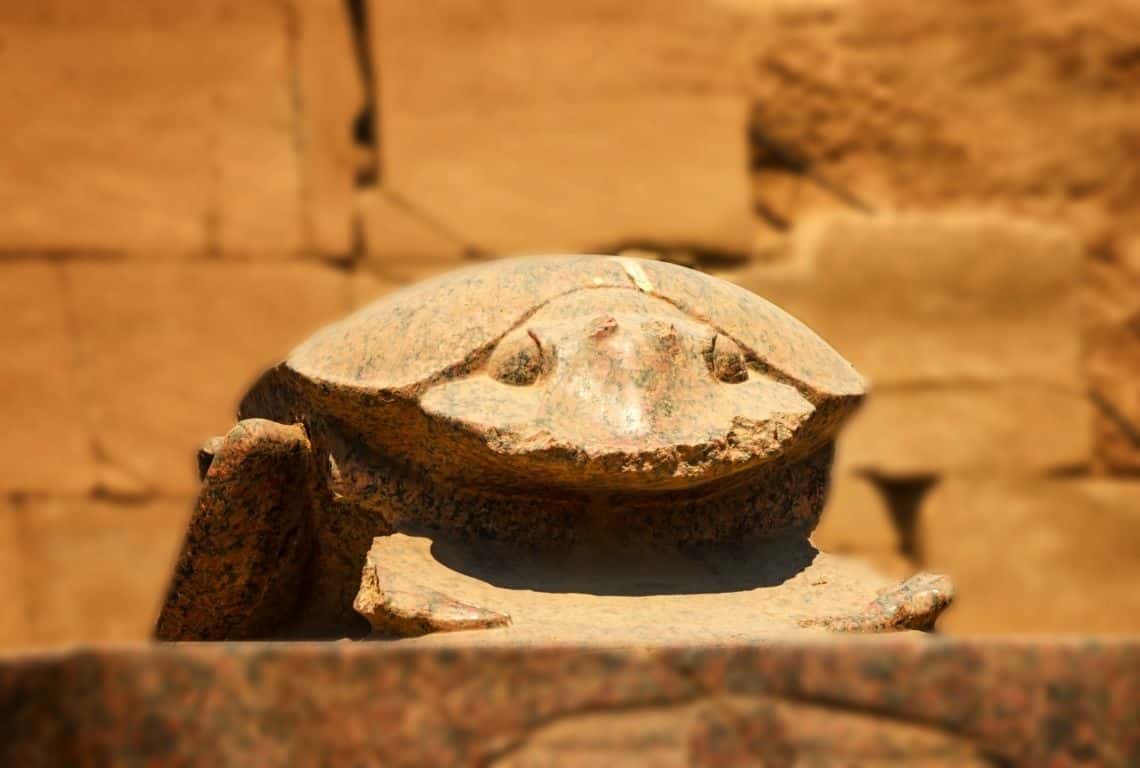
The Egyptians saw the Egyptian scarab (Scarabaeus sacer) as a symbol of renewal and rebirth / What to See at Karnak Temple
Don't Miss the Sound and Light Show at Karnak Temple
I have to be honest and say that the Sound and Light Show at Karnak Temple is rather unexciting. It goes on for about an hour and a half and recounts the history of Thebes (Luxor) and covers the lives of several pharaohs who contributed to the construction of the temple complex.
However, the entrance ticket allows you to see the temple complex beautifully illuminated. And, that is why you should go! You will be amazed at how incredible the temple complex looks at night with the structures and statues lit up.
You can purchase the entrance tickets online.
Also, make sure to double-check the schedule, since shows are done in different languages at different times.
Intrepid Scout's Tips for How to Visit Karnak Temple
- Karnak Temple is open daily from 6:30 am until 5:30 pm in winter and from 6 am to 6 pm during summer. If you are visiting during the summer months, then schedule your tour of Karnak Temple either early in the morning or late in the afternoon.
- The all-inclusive entrance ticket to Karnak Temple costs 200 EGP and it covers the open-air museum and the temple complex. By the way, the open-air museum is located to the left of the Second Pylon and contains a collection of statues excavated within the temple area. You can purchase the ticket at the entrance to the Temple of Karnak.
More Information About Egypt
How to Visit and What to See at KHAN EL-KHALILI BAZAAR in Cairo
Perfect 7-Day Egypt Itinerary for First Visit (Cairo, Aswan, Luxor, Abu Simbel)
What to See at the TEMPLE of HORUS at EDFU (5 Things You Can’t Miss)
10 Epic Things to See and Do at the Pyramids of Giza
What to See at the TEMPLE of KOM OMBO, Egypt (9 Things You Can’t Miss)
How to Visit Abu Simbel: Everything You Need to Know to Plan Your Visit
How to Visit and What to See at the TEMPLE of PHILAE in Aswan
Best Day Trip from Cairo – Dahshur, Memphis, and Saqqara (Maps+Photos)
Now, It Is Your Turn, I Would Like to Hear Back from You!
Are you planning your trip to Luxor?
Please let me know! Drop me a quick comment right below!
Click on any of the images below to get inspired and to help you with the planning process for your trip to Luxor or Egypt!
Did You Find This Useful?
Why Not Save How to Visit Karnak Temple to Your Pinterest Board!
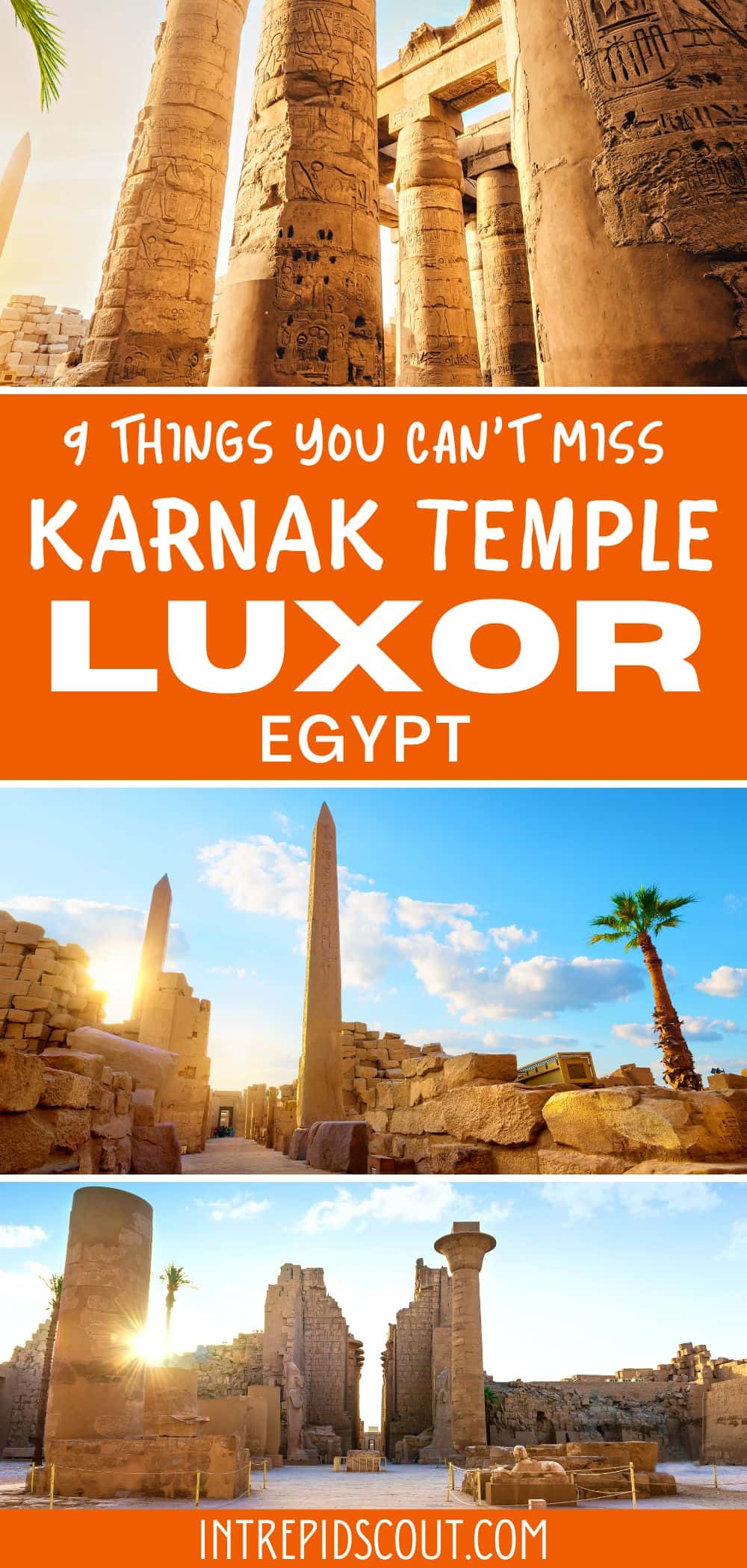
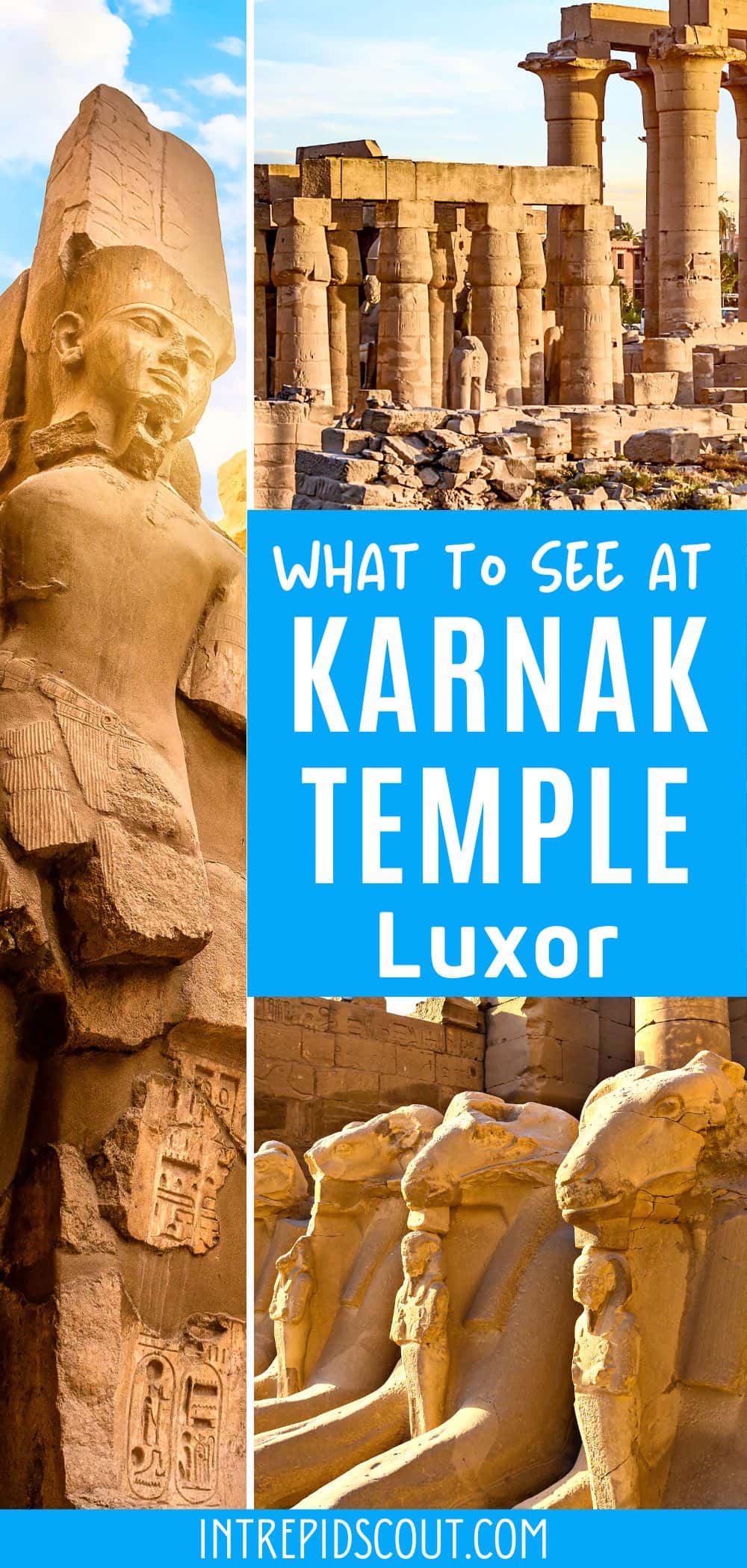
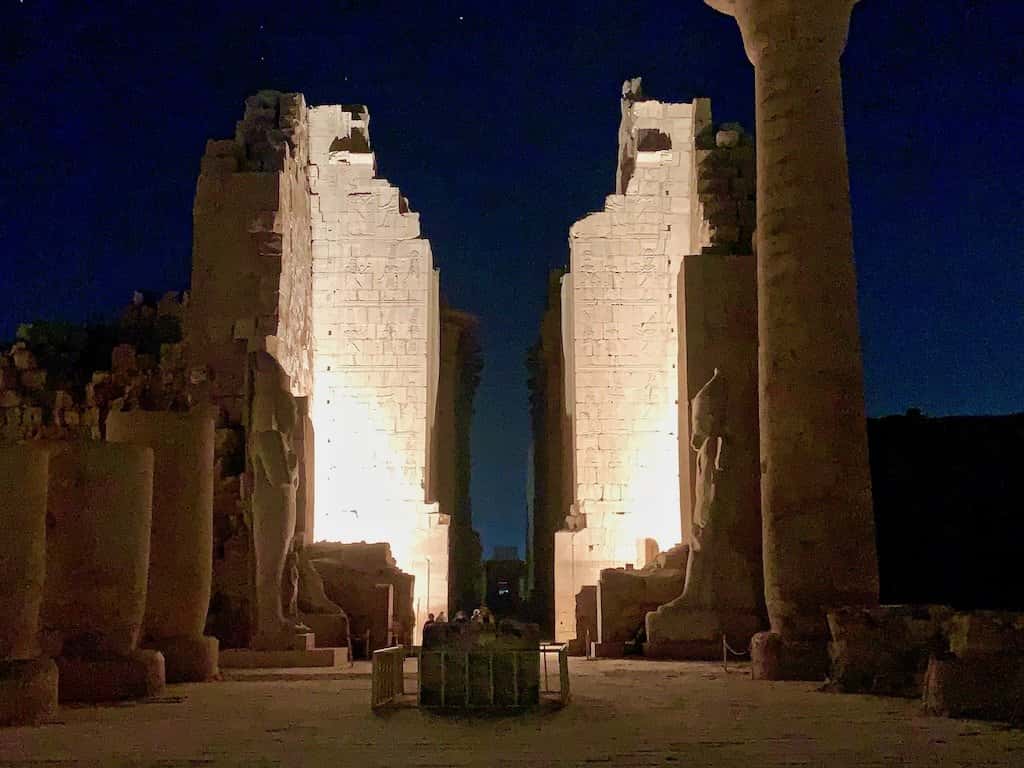
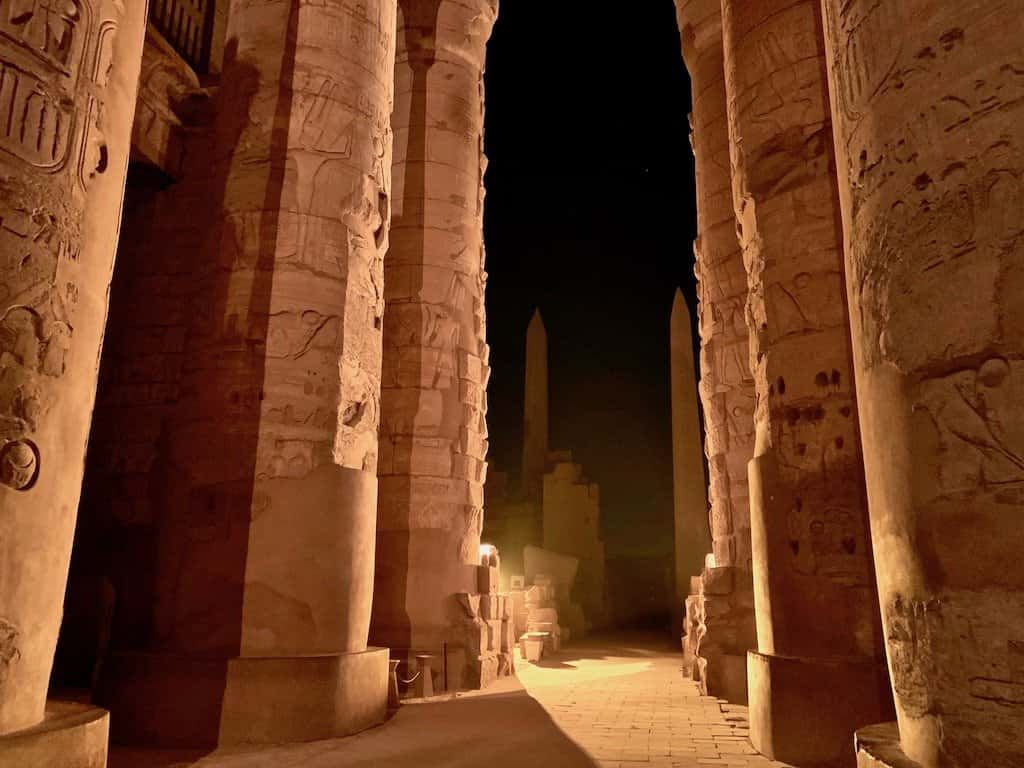
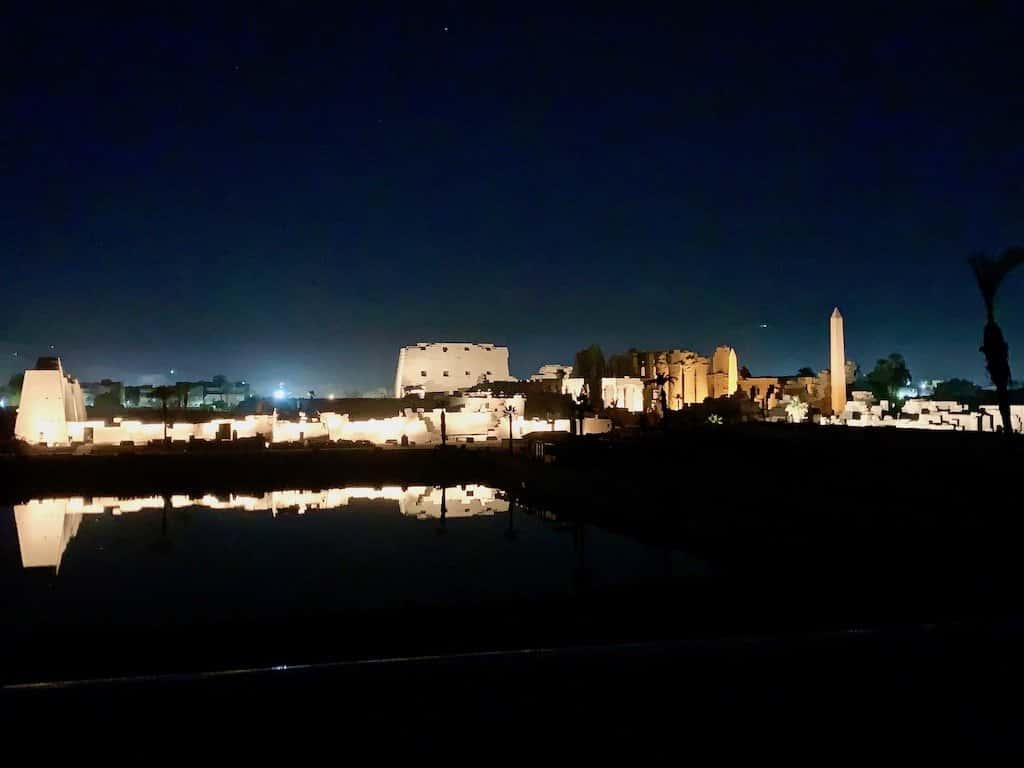
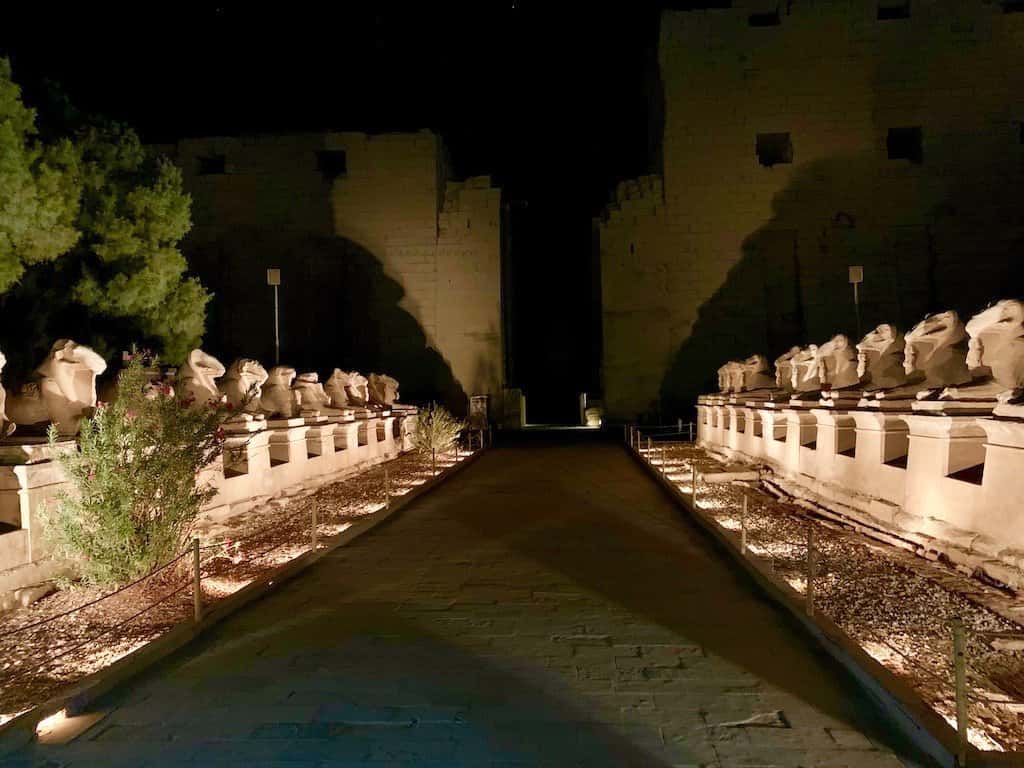
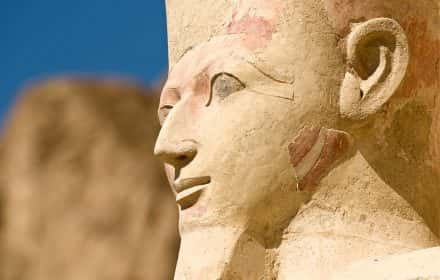
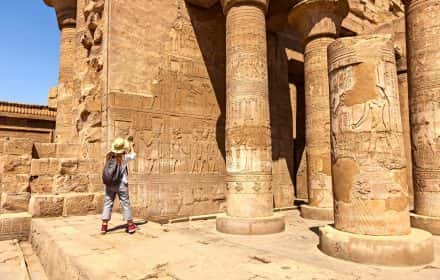
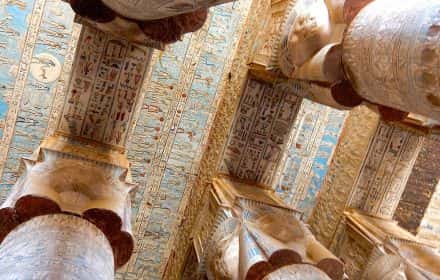
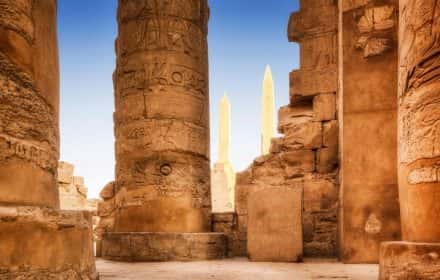
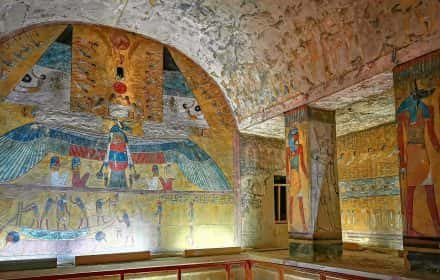
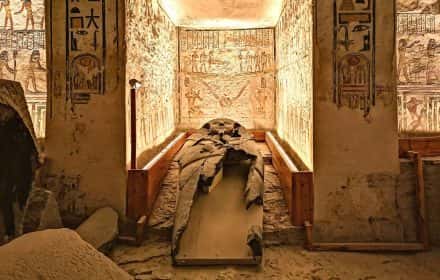
Comments:
2 thoughts on “How to Visit KARNAK TEMPLE in Luxor (Best Guide with 9 Things You Can’t Miss!)”
Hello! I just read your blog post about Karnak Temple. It was so helpful thank you!! You mentioned your hired a private driver and tour guide. Do you have his or her information? I would like to also use them. How much was it? Thank you so much!
Hi Katelyn,
I am glad you found it helpful.
My recommendation is to review my post:14 Egypt Tips for First Timers
https://www.intrepidscout.com/egypt-travel-tips/
It has all the information you are looking for.
Good luck with everything.